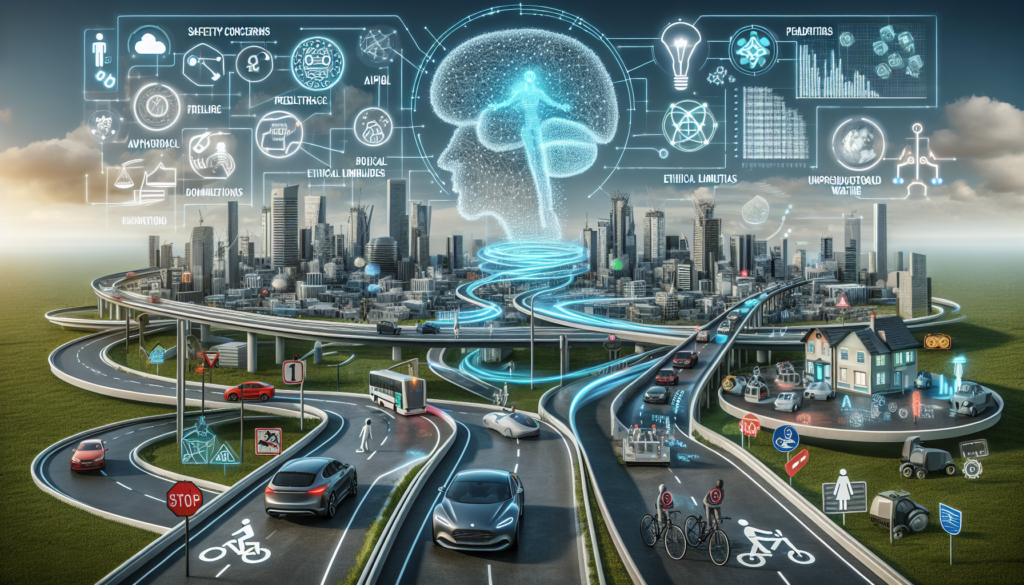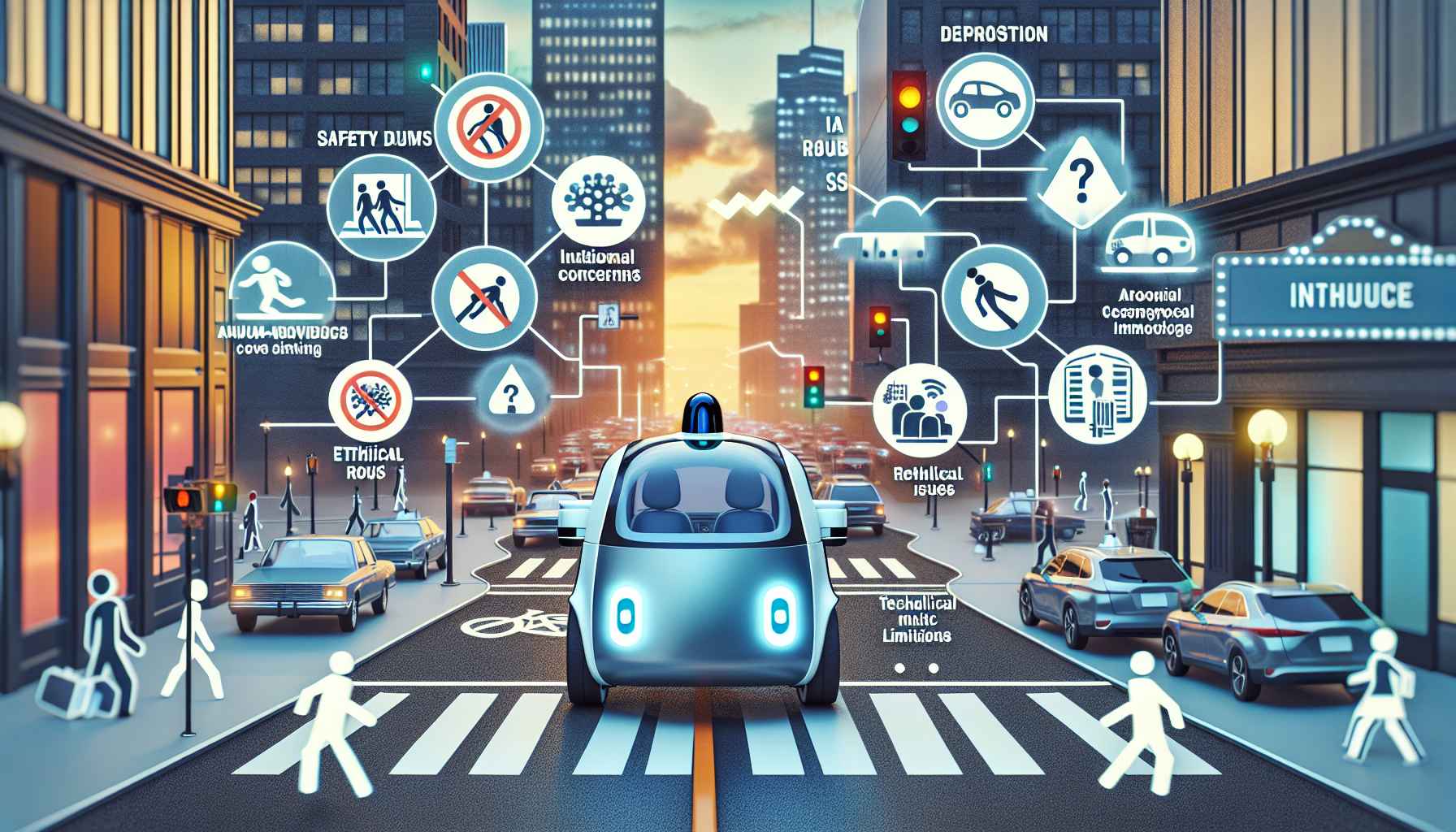In the fast-paced and rapidly evolving world of technology, the emergence of AI-driven autonomous vehicles has revolutionized the way we envision transportation. However, behind the remarkable advancements lie a myriad of challenges that need to be addressed. From ensuring safety and reliability to overcoming legal and ethical hurdles, the journey towards a fully autonomous future is not without its obstacles. Explore the key challenges that AI-driven autonomous vehicles face and understand the complexities that come with this technological marvel.

Safety and Reliability
Cybersecurity risks
When it comes to AI-driven autonomous vehicles, cybersecurity risks pose a significant challenge. With increased connectivity and reliance on various communication networks, these vehicles become vulnerable to cyber threats. Hackers could potentially gain control over the vehicle’s systems, leading to dangerous situations. Therefore, it is crucial for manufacturers to prioritize the development of robust cybersecurity measures to protect these vehicles from malicious attacks.
Robustness to unforeseen scenarios
Autonomous vehicles must be capable of handling unforeseen scenarios on the roads. Whether it’s encountering erratic drivers, unpredictable pedestrians, or unexpected road closures, these vehicles need to adapt and react appropriately to ensure the safety of everyone on the road. Developing robust algorithms that can recognize and respond effectively to these scenarios is a significant challenge that the industry is currently working to overcome.
Liability and ethical concerns
As autonomous vehicles become more prevalent on our roads, the issue of liability and ethical concerns arises. In the event of an accident involving an autonomous vehicle, determining who is responsible becomes complex. Should it be the driver, the manufacturer, or the AI algorithm that made the decision? Additionally, autonomous vehicles may face ethical dilemmas, such as the infamous “trolley problem,” where the AI algorithm must choose the lesser of two potential harms. Balancing safety and liability with ethical considerations remains an ongoing challenge for the autonomous vehicle industry.
Sensor Technology
Limited perception capabilities
The sensory systems of autonomous vehicles are critical for perceiving the surrounding environment accurately. However, current sensor technology has limitations in its perception capabilities. Factors such as low-light conditions, adverse weather, and occluded objects can pose challenges for these sensors, potentially leading to errors in perception. Improving sensor technology to ensure reliable detection and interpretation of the environment is crucial to enhance the safety and reliability of autonomous vehicles.
Weather conditions and environmental factors
Autonomous vehicles operate in various weather conditions and environmental settings, which can significantly impact their performance. Rain, snow, fog, or extreme temperatures can affect sensor accuracy and reliability, making it difficult for autonomous vehicles to navigate effectively. Developing sensor technology that can mitigate the impact of adverse weather conditions and environmental factors is a key challenge to ensure the safe operation of these vehicles in any situation.
Sensor fusion challenges
Autonomous vehicles rely on multiple sensors, including cameras, lidar, radar, and ultrasonic sensors, to gather information about their surroundings. Integrating the data from these diverse sensors into a cohesive understanding of the environment is a complex challenge. Sensor fusion algorithms need to accurately combine and interpret the information from each sensor to make optimal decisions. Developing robust sensor fusion techniques that can handle the variability and complexity of real-world driving scenarios is a crucial obstacle in the advancement of AI-driven autonomous vehicles.
Machine Learning and AI Algorithms
Real-time decision-making
Autonomous vehicles must make real-time decisions to navigate safely and efficiently. Machine learning and AI algorithms play a crucial role in enabling these vehicles to analyze sensor data, predict potential outcomes, and take appropriate action. However, achieving real-time decision-making while considering multiple factors, such as road conditions, traffic, and pedestrian behavior, presents a significant challenge. Developing efficient algorithms that can process data quickly and make accurate decisions in real-time is essential for the successful deployment of autonomous vehicles.
Limited data availability
Training AI algorithms for autonomous vehicles requires vast amounts of data. However, obtaining sufficient and diverse real-world data that covers a wide range of driving scenarios can be challenging. Furthermore, certain rare events or hazardous situations are difficult to capture in data collection. The limitation in data availability poses a challenge for training AI algorithms effectively. Researchers and manufacturers need to find ways to augment training data or leverage simulated environments to overcome this hurdle.
Avoiding overfitting and underfitting
Machine learning algorithms used in autonomous vehicles need to strike a delicate balance between overfitting and underfitting. Overfitting occurs when the algorithm learns the training data too well, leading to poor generalization and inability to handle new situations. On the other hand, underfitting happens when the model fails to learn the underlying patterns and performs poorly on the test data. Achieving the right level of generalization to adapt to different driving scenarios without compromising performance or safety remains a critical challenge in the development of AI-driven autonomous vehicles.
Regulation and Legal Framework
Establishing safety standards
As autonomous vehicles become more commonplace, establishing safety standards becomes paramount. Regulatory bodies and governmental organizations need to collaborate with manufacturers and researchers to develop comprehensive safety standards that guide the design, operation, and maintenance of autonomous vehicles. Ensuring the safety of passengers, pedestrians, and other road users while fostering innovation and technological advancements presents a complex challenge that requires careful consideration.
Legal responsibility and liability
Determining legal responsibility and liability in the event of an accident involving autonomous vehicles remains a challenging task. With the involvement of AI algorithms and complex systems, attributing fault or negligence becomes more complex, potentially requiring updates to current legal frameworks. Policymakers and legal experts need to navigate these intricacies to establish clear guidelines that allocate responsibility in a fair and just manner.
Data privacy and ownership
Autonomous vehicles generate an enormous amount of data, including sensor data, location information, and personal preferences. Protecting this data while respecting privacy rights poses a significant challenge. Manufacturers and regulators must establish robust data protection mechanisms to safeguard individuals’ information and prevent unauthorized access. Additionally, determining ownership and control over this data is another difficult question that must be addressed within the legal framework.

Infrastructure and Connectivity
Developing communication protocols
To enable efficient communication and coordination between autonomous vehicles and infrastructure, developing standardized communication protocols is crucial. These protocols need to handle complex traffic scenarios, share real-time information, and ensure reliable transmission of data. Establishing a unified communication framework that allows seamless interaction between vehicles and infrastructure remains a technical challenge that requires collaboration and standardization efforts.
Network reliability and latency
Reliable connectivity is essential for the proper functioning of autonomous vehicles. However, network reliability can vary, and latency issues can arise, adversely impacting real-time decision-making and communication. Ensuring stable and low-latency network connections between vehicles and infrastructure, even in remote or challenging areas, presents a significant infrastructure challenge that needs to be addressed for the widespread adoption of autonomous vehicles.
Adapting existing infrastructure
The current road infrastructure was primarily designed for human-driven vehicles. Adapting this infrastructure to support the safe and efficient operation of autonomous vehicles poses a significant challenge. Upgrading road signs, traffic lights, and lane markings, as well as integrating new technologies like vehicle-to-infrastructure communication, requires extensive planning and investment. Collaborative efforts between governments, urban planners, and transportation agencies are crucial to overcome these infrastructure challenges and create an environment conducive to autonomous vehicle adoption.
Technical Challenges
Map creation and updates
Accurate and up-to-date maps play a vital role in autonomous vehicle navigation. However, mapping the entire road network and maintaining accurate maps in real-time is an enormous undertaking. Roads undergo changes, construction, and temporary closures, necessitating constant updates to the maps. Developing automated mapping systems that can keep up with these changes and provide accurate information to autonomous vehicles is a technical challenge that requires innovative solutions and seamless integration with existing mapping infrastructure.
Varying road conditions and signs
Road conditions can vary significantly, from well-maintained highways to rough and challenging surfaces. Autonomous vehicles need to be able to adapt to these varying conditions and make appropriate decisions. Similarly, road signs and markings can differ regionally, potentially causing confusion for AI algorithms. Overcoming these challenges by developing robust algorithms that can handle diverse road conditions and efficiently interpret different sign formats is crucial for the safe and reliable operation of autonomous vehicles.
Localization and navigation in complex environments
Navigating complex environments, such as dense urban areas or construction zones, can pose challenges for autonomous vehicles. Precise localization and accurate understanding of the surroundings are critical, especially when dealing with crowded streets or temporary modifications to the road layout. Overcoming these challenges involves developing advanced algorithms that can handle complex mapping, localization, and navigation to ensure safe and efficient traversal of challenging environments.
Human Interaction
User trust and acceptance
For the widespread adoption of autonomous vehicles, user trust and acceptance are crucial factors. Convincing people to trust and rely on machines for their safety on the roads requires addressing concerns and misconceptions. Clear communication about the capabilities, limitations, and safety features of autonomous vehicles can help build trust and increase acceptance among potential users. Public education and awareness campaigns are vital to fostering a positive perception and encouraging the adoption of autonomous technology.
Intuitive user interfaces
Designing intuitive user interfaces (UI) for autonomous vehicles is essential to ensure a smooth and comfortable user experience. The UI should provide clear and easily understandable information while minimizing distractions and cognitive load for the occupants. Developing intuitive interfaces that allow passengers to interact effectively with the autonomous systems while maintaining situational awareness is a design challenge that requires human-centric approaches and iterative improvements based on user feedback.
Emergency situations
Handling emergency situations is another critical aspect of autonomous vehicle design. When faced with a sudden crisis, such as a collision or a medical emergency, autonomous vehicles must respond appropriately and swiftly. Ensuring that the vehicle can recognize and react to emergency situations, prioritize human safety, and alert appropriate authorities or emergency responders is a challenge that requires robust emergency protocols and coordination with existing emergency management systems.
Cost and Affordability
Integration and manufacturing costs
Developing and integrating AI-driven autonomous technology into vehicles can involve significant costs, which may impact the affordability of autonomous vehicles. Manufacturers need to find ways to optimize production processes, reduce manufacturing costs, and ensure cost-effective integration of autonomous technology. Achieving affordability without compromising safety and reliability is a crucial challenge that must be addressed to make autonomous vehicles accessible to a broader range of consumers.
Upgrading existing vehicle fleets
Autonomous technology is not limited to new vehicles; there is also a need to upgrade existing vehicle fleets. However, retrofitting or adapting traditional vehicles with autonomous capabilities can be challenging due to varying designs and technologies. Ensuring seamless integration and retrofitting without compromising performance or safety is a technical and logistical challenge that requires careful planning and expertise.
Infrastructure investments
The successful deployment of autonomous vehicles requires substantial infrastructure investments. Developing communication networks, implementing intelligent transportation systems, and upgrading road infrastructure all demand significant financial resources. Governments, private entities, and stakeholders need to collaborate in investing in the necessary infrastructure to support the safe and efficient operation of autonomous vehicles. Balancing the costs and benefits and strategizing long-term investments is a challenge that requires coordination and foresight.
Ethical Considerations
Decision-making in unavoidable accidents
Autonomous vehicles may encounter situations where accidents are unavoidable, presenting ethical dilemmas. In such situations, AI algorithms must make decisions that minimize harm and prioritize the safety of all involved. Determining the ethical guidelines and programming these decisions into the algorithms is a complex challenge that requires careful consideration and involvement from ethicists, policymakers, and the public.
Prioritizing safety over human choices
Autonomous vehicles are designed to prioritize safety above all else. However, conflicts may arise when prioritizing safety means making decisions that could potentially sacrifice the safety of the occupants or others. Striking the right balance to ensure the safety of all while minimizing harm is an ethical challenge that requires thorough discussions and consensus-building among stakeholders.
Job displacement and social impact
The widespread adoption of autonomous vehicles has the potential to disrupt various industries, most notably transportation and logistics. With increased automation, there is a concern about job displacement and the socio-economic impact on affected communities. Addressing these concerns and preparing for the future of work by providing retraining opportunities and social support is an ethical consideration that needs to be taken into account alongside technological advancements.
Public Perception and Adoption
Acceptance of autonomous technology
Public perception plays a crucial role in the adoption of autonomous technology. Building public trust and acceptance requires alleviating concerns, debunking myths, and addressing misunderstandings. Providing transparent information, showcasing the benefits, and highlighting safety records can help increase public acceptance of autonomous vehicles. Widespread education campaigns and demonstrations can also allow people to experience and understand the potential advantages of autonomous technology, leading to increased acceptance.
Dealing with public skepticism
Despite the potential benefits, there exists skepticism and resistance towards autonomous vehicles. Concerns about safety, reliability, and loss of control can contribute to this skepticism. Addressing these concerns through transparent communication, rigorous testing, and data-driven evidence is crucial to overcome public skepticism. Engaging with public stakeholders, listening to their feedback, and incorporating their perspectives can contribute to building a positive perception among the public.
Education and awareness campaigns
Educating the public about the capabilities, limitations, and benefits of autonomous vehicles is paramount for their successful adoption. Many individuals may not be aware of the advancements in technology or the potential positive impact that autonomous vehicles can have on society. Conducting widespread education and awareness campaigns through various channels, such as media, community events, and digital platforms, can help bridge the knowledge gap and foster greater understanding and acceptance of autonomous technology.
In conclusion, AI-driven autonomous vehicles hold tremendous potential to revolutionize transportation and improve road safety. However, significant challenges must be overcome to ensure their safe and reliable deployment. From cybersecurity risks and sensor technology limitations to regulatory frameworks and public perception, addressing these challenges requires collaboration among various stakeholders, including manufacturers, policymakers, and the public. By tackling these obstacles head-on and finding innovative solutions, we can pave the way for a future where autonomous vehicles seamlessly coexist with human-driven vehicles, making our roads safer, more efficient, and less congested.





















